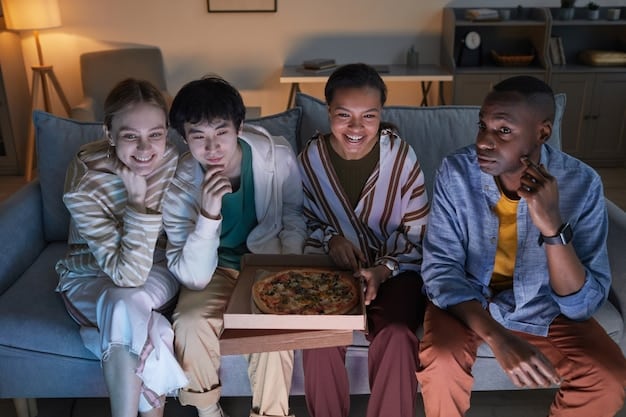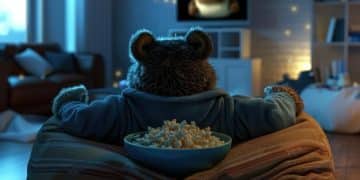Psychology of Binge-Watching: Why We Do It & How to Do It Better

The compelling allure of binge-watching stems from a complex interplay of psychological factors, including the desire for escape, dopamine release, narrative closure, and social connection, fundamentally influencing how we engage with digital content and offering avenues for more balanced consumption.
Have you ever found yourself immersed in a television series, watching episode after episode well into the night, promising that “just one more” turns into five? This common contemporary phenomenon, known as “binge-watching,” has profoundly reshaped our entertainment habits. Understanding The Psychology of Binge-Watching: Why We Do It and How to Do It Better can illuminate the forces driving this pervasive behavior, offering insights into both its draws and how we can approach it more mindfully.
The Allure of Narrative Immersion
The concept of binge-watching, at its core, is deeply tied to our innate human desire for narrative. We are story-consuming beings, and the continuous flow of episodes offered by streaming platforms caters to this fundamental need in an unprecedented way. Unlike traditional television, where waiting a week for the next installment was the norm, streaming removes artificial barriers, allowing for uninterrupted story progression.
This seamless experience fosters a profound sense of immersion. When we watch a single episode, our brains engage with characters and plotlines. With binge-watching, this engagement deepens, creating a continuous feedback loop. The suspense of a cliffhanger immediately resolved by the next episode pulls us further into the fictional world, making it increasingly difficult to disengage. This continuous flow prevents the “cooling off” period that weekly releases provided, keeping the narrative tension high.
The Power of Narrative Closure
Our brains are hardwired to seek completion and resolution. This psychological principle, known as the Zeigarnik effect, suggests that uncompleted tasks or unresolved narratives tend to stick in our minds more persistently than those that are finished. A cliffhanger at the end of an episode acts as an open loop, creating a nagging curiosity that demands closure.
* Unresolved Plots: Each episode often ends with questions unanswered, pushing viewers to seek immediate resolution.
* Character Arcs: The desire to see beloved characters overcome challenges or achieve their goals compels continued viewing.
* World-Building: Complex fictional universes invite deeper exploration, rewarding viewers who invest time in understanding their intricacies.
Flow and Escapism
Binge-watching can induce a state of “flow,” a term coined by psychologist Mihaly Csikszentmihalyi, where an individual becomes completely absorbed in an activity. During flow, time seems to disappear, and self-consciousness fades. This deep absorption makes binge-watching a potent form of escapism. It allows individuals to temporarily disengage from real-world stresses, responsibilities, or anxieties, offering a mental vacation within a crafted narrative world. The consistent nature of binge-watching enables this sustained escape, blurring the lines between reality and fiction for extended periods. This immersive experience provides a temporary reprieve from daily pressures, a compelling benefit for many.
The continuous progression feeds our brain’s reward system, releasing dopamine with each plot twist or resolved storyline. This neurochemical process makes the activity inherently pleasurable and reinforces the behavior, solidifying the urge for “just one more episode.” The cumulative effect of these psychological mechanisms makes narrative immersion a powerful driver behind the pervasive appeal of binge-watching.
The Dopamine Loop and Brain Chemistry
The human brain is intricately wired for reward, and the experience of binge-watching taps directly into this fundamental system. When we engage in activities that are pleasurable, our brains release dopamine, a neurotransmitter associated with pleasure, motivation, and learning. This is not merely about feeling good; it’s about reinforcing behaviors that lead to positive outcomes. In the context of binge-watching, this creates a powerful feedback loop.
As a viewer progresses through a series, each new plot development, character revelation, or satisfying resolution triggers a surge of dopamine. This chemical rush signals to the brain that this activity is rewarding, encouraging its repetition. Cliffhangers, in particular, exacerbate this effect. They create a state of anticipation and mild tension, which is then released with the start of the next episode, providing a further burst of dopamine. This cyclical pattern makes it difficult to stop, as our reward system actively seeks out the next dose of this pleasurable neurochemical.
The Role of Anticipation and Reward
Anticipation itself can be a powerful driver of dopamine release. The mere expectation of a satisfying plot twist or character development can be as rewarding as the event itself. With binge-watching, the next “reward” is immediately available, eliminating the need to wait. This instant gratification bypasses the natural breaks that traditional television viewing imposed, leading to a more intense and continuous dopamine release.
* Instant Gratification: No waiting for next week’s episode means immediate satisfaction of curiosity.
* Predictable Rewards: The brain learns that continued watching consistently delivers pleasure.
* Habit Formation: Repeated engagement with this reward cycle can lead to the formation of a habit, making binge-watching an automatic response to free time.
Desensitization and Escalation
Over time, the brain can become accustomed to certain levels of dopamine stimulation, a phenomenon known as desensitization. This means that larger or more frequent stimuli might be required to achieve the same level of pleasure. For binge-watchers, this could translate into needing to watch more episodes, or even entire seasons, to get the same “fix.” This escalation can push viewing sessions to extreme lengths, further disrupting sleep patterns and other daily activities.
The ease of access provided by streaming platforms facilitates this desensitization. With an endless library of content just a click away, there’s always something new to fuel the dopamine loop. This constant availability, coupled with the brain’s natural adaptation to stimuli, contributes significantly to the addictive quality some people experience with binge-watching. Understanding this neurochemical dance helps explain why “just one more episode” often turns into an all-night affair.
The Social and Emotional Dimensions
Beyond the individual psychological pulls, binge-watching also deeply intertwines with our social structures and emotional regulation needs. It’s not always a solitary activity; it often bridges connections, fosters shared experiences, and plays a role in how we manage our feelings. The communal aspect, even when physically separate, adds a significant layer to its appeal.
Shared Experiences and FOMO
In an increasingly connected world, conversations around popular culture, particularly TV series, are ubiquitous. Binge-watching allows individuals to participate in these cultural touchstones, forming bonds with friends, family, or even online communities. The fear of missing out (FOMO) on these discussions and the desire to be “in the know” can be a powerful motivator. Being able to discuss plot twists, fan theories, or character developments in real-time creates a sense of belonging and validates the shared investment in a narrative. This social currency encourages rapid consumption of new content to keep pace.
The rise of social media further amplifies this phenomenon, with platforms dedicated to discussing TV shows. Live-tweeting an episode premiere or engaging in online forums about a series’ ending becomes part of the viewing experience, transforming a private activity into a public one. This collective engagement contributes to the pressure to binge, ensuring one doesn’t fall behind the cultural conversation.

Emotional Regulation and Comfort
For many, binge-watching serves as a coping mechanism for emotional distress, stress, or boredom. Immersing oneself in a fictional world provides a temporary escape from difficult emotions or tedious realities. The predictability of a beloved series, the comforting familiarity of recurring characters, and the controlled environment of a narrative can offer a sense of safety and solace. It’s a low-effort way to self-soothe, providing a predictable source of distraction and emotional relief.
* Stress Relief: Provides a temporary mental break from daily pressures.
* Emotional Connection: Viewers often form strong attachments to characters, experiencing their joys and sorrows.
* Predictability: The structured nature of a series offers a sense of control and comfort in an unpredictable world.
Moreover, binge-watching can be a form of self-care for some, a way to unwind and recharge after a long day. The passive nature of the activity allows for mental deceleration, providing a contrast to the demands of active work or social interaction. While not always healthy if taken to extremes, the emotional and social dimensions of binge-watching underscore its multifaceted role in contemporary life, highlighting its capacity to fulfill needs beyond mere entertainment.
The Impact on Well-being and Habits
While the immediate gratification and immersive escapism of binge-watching are undeniable, its long-term effects on well-being and daily habits are a subject of growing discussion and research. The convenience of streaming, which allows for boundless consumption, also removes inherent breaks that traditionally regulated our media intake, leading to potential consequences that warrant consideration.
One of the most noticeable impacts is on sleep patterns. Prolonged viewing sessions, especially late into the night, significantly reduce the quantity and quality of sleep. The blue light emitted from screens can suppress melatonin production, a hormone essential for regulating sleep, making it harder to fall asleep even after deciding to stop. Furthermore, the stimulating nature of narrative content can keep the brain active, preventing it from winding down effectively.
Physical and Mental Health Considerations
Beyond sleep, extended periods of sedentary behavior associated with binge-watching can impact physical health. Increased time spent sitting can contribute to a range of issues, including poor circulation, muscular strain, and a reduced metabolism, potentially leading to weight gain. Mentally, while providing temporary relief, excessive binge-watching might also be linked to increased feelings of isolation, anxiety, or even depression for some individuals, particularly if it replaces real-world interactions or productive activities.
* Eye Strain and Headaches: Prolonged screen time can lead to discomfort.
* Poor Nutrition: Often accompanied by mindless snacking on unhealthy foods.
* Reduced Physical Activity: Replaces opportunities for exercise or outdoor activities.
Disruption of Routines and Boundaries
The absence of natural stopping points in streaming content can make it challenging to establish boundaries. Daily routines can be easily disrupted as viewing sessions bleed into hours meant for work, chores, or social engagements. This blurring of lines can lead to a sense of lost time or unfulfilled responsibilities, affecting overall productivity and well-being. The ease with which one episode flows into the next creates a continuous loop that feels difficult to break, as the decision to stop requires conscious effort against a highly engaging stimulus.
Moreover, the instant access to vast libraries of content can cultivate a culture of instant gratification, potentially diminishing patience and the ability to find enjoyment in activities that require delayed rewards. Recognizing these potential impacts is the first step towards developing healthier viewing habits, ensuring that entertainment remains a source of pleasure and not a detriment to overall well-being.
Strategies for Healthier Binge-Watching
Recognizing the allure and potential pitfalls of binge-watching is crucial, but the goal isn’t necessarily to eliminate it entirely. Rather, it’s about fostering a more mindful and balanced approach to consuming content. Developing healthier habits allows us to enjoy our favorite shows without sacrificing sleep, productivity, or real-world connections. The key lies in implementing deliberate strategies that introduce structure and self-awareness into our viewing patterns.
Setting Intentional Boundaries
One of the most effective strategies is to establish clear and intentional boundaries before starting a viewing session. This means deciding beforehand how many episodes you plan to watch, or for how long you will watch. Use alarms or timers to signal when your designated viewing time is up.
* Episode Limits: Commit to watching only 1-2 episodes per session.
* Time Constraints: Set a specific end time (e.g., “I will stop watching by 9 PM”).
* Pre-planned Breaks: Schedule short breaks between episodes to stand up, stretch, or grab a drink.
These boundaries introduce a crucial element of conscious decision-making into an activity that often becomes automatic. By pre-determining your limits, you reduce the temptation to continuously watch “just one more.”
Engaging Actively with Content
Instead of passively consuming, try to engage more actively with the content. This could involve discussing episodes with friends, joining online forums, or even keeping a brief journal of your thoughts and predictions. Active engagement transforms viewing from a purely absorptive activity into a more interactive one, making it less likely to be used purely as a form of escapism from reality.
Conscious Choices and Alternatives
Before hitting “play,” take a moment to consider why you want to watch. Is it for genuine enjoyment, or are you seeking to avoid something else? If it’s the latter, explore alternative activities that might address the underlying need more effectively.
* Engage in Hobbies: Pick up a book, pursue a craft, or learn a new skill.
* Physical Activity: Go for a walk, exercise, or play a sport.
* Socialize: Connect with friends or family in person or through video calls.
By consciously choosing how and why we engage with content, we can shift from reactive consumption to proactive entertainment. Incorporating these strategies can help transform binge-watching from a potentially overwhelming habit into a truly enjoyable and balanced part of our leisure time.
The Future of Storytelling and Consumption
The rise of streaming and binge-watching has irrevocably altered the landscape of storytelling and content consumption. This shift is not merely a transient trend but a fundamental change in how narratives are designed, distributed, and absorbed by audiences. As platforms continue to innovate, and as audiences become more adept at customizing their viewing experiences, the evolution of storytelling will likely accelerate, bringing forth new opportunities and challenges.
One significant shift is towards narratives designed for continuous consumption. Writers and producers now often craft entire seasons as extended movies, with overarching plotlines and less emphasis on episodic resolution. This “novelistic” approach leverages the binge-watching habit, rewarding viewers who commit to longer story arcs and intricate character developments. This also opens doors for more complex storytelling, as the need to recap previous episodes or re-establish plot points is reduced significantly.
Personalization and Recommendation Algorithms
The future of consumption is also deeply intertwined with advanced personalization and recommendation algorithms. Streaming platforms are becoming increasingly sophisticated at predicting what viewers will enjoy, based on their past viewing habits, genre preferences, and even emotional responses to content. This hyper-personalization, while convenient, also poses questions about filter bubbles and the potential for audiences to be exposed to a limited range of perspectives or genres.
* Tailored Content: Algorithms suggest shows highly likely to appeal to individual tastes.
* Discovery Barriers: Viewers might be less likely to stumble upon content outside their established preferences.
* Reinforcement of Habits: Recommendations can inadvertently encourage more binge-watching by consistently promoting engaging series.

Interactive and Diversified Consumption
Looking ahead, we might see a greater integration of interactive elements within narratives, allowing viewers to make choices that influence the storyline, similar to choose-your-own-adventure books. This could further deepen immersion and personalize the viewing experience in unprecedented ways. Furthermore, as attention spans continue to evolve, there might be a greater diversification in content formats, including micro-series, short-form narratives, and even augmented reality experiences that blend digital stories with the physical world.
The future will likely see a balance between the compelling nature of binge-watching and a renewed emphasis on active, mindful consumption. As audiences become more aware of their own viewing habits and their impact, there will be a greater demand for tools and features that support healthier engagement, allowing for both deep dives into captivating narratives and conscious disengagement. This evolving landscape promises a dynamic future for both storytellers and their audiences.
Practical Tips for a Better Binge-Watching Experience
Having explored the psychological underpinnings and broader impacts of binge-watching, it’s clear that while the activity is appealing, it benefits from a more intentional approach. Achieving a better binge-watching experience isn’t about abstinence, but about moderation and self-awareness. These practical tips are designed to help you harness the enjoyment of continuous viewing without falling into potential pitfalls, ensuring that your entertainment serves your well-being, not the other way around.
Schedule Your Binge Sessions
Just as you schedule appointments or workouts, allocate specific times for your binge-watching. This transforms a potentially spontaneous and endless activity into a planned leisure pursuit. Treat it like a special event. For example, dedicate Friday nights or Sunday afternoons as your designated viewing times. Knowing when your session begins and ends can significantly reduce the likelihood of it disrupting other important aspects of your life. Make sure to schedule in breaks for meals or movement.
* Weekend Blocks: Reserve specific hours on weekends for extended viewing.
* Evening Wind-down: Set a strict cut-off time for weekday watching to protect sleep.
* Pre-planned Breaks: Use commercial breaks (if watching live TV) or pause points (on streaming) to stretch or hydrate.
Create a Conducive Environment
The environment where you binge-watch can heavily influence your experience. Optimize your space for comfort, but also for conscious consumption. Avoid watching in bed, especially if it leads to sleep disruption. A dedicated viewing area, free from distractions, can enhance focus and enjoyment. Also, prepare healthy snacks and drinks beforehand to avoid reaching for unhealthy options out of convenience.
Practice Mindful Consumption
Pay attention to how binge-watching makes you feel both during and after a session. Are you genuinely enjoying it, or are you just watching out of habit or boredom? If you find yourself feeling tired, unfocused, or guilty, it might be a sign to take a break or adjust your viewing habits. Engage your senses: appreciate the cinematography, the music, or the acting. This active engagement can make the experience more enriching than passive absorption.
Consider using breaks between episodes to reflect on the content or engage in a quick non-screen activity, like stretching or talking to a family member. Building in these small intermissions can help reset your mind and provide a clearer sense of how much you’ve watched, making it easier to decide when to stop. Ultimately, a better binge-watching experience is one that you control, allowing you to immerse yourself in captivating stories while maintaining a healthy balance in your life.
Understanding the “Cliffhanger Effect”
The “cliffhanger effect” is a cornerstone of modern storytelling, particularly in episodic narratives, and it plays an undeniable role in fueling binge-watching behavior. It’s a deliberate narrative device designed to create an intense moment of suspense or unresolved tension at the end of an episode, compelling viewers to immediately seek out the next installment. This psychological hook taps into our inherent desire for narrative closure and resolution.
The Neuroscience Behind the Urge
From a neurological perspective, cliffhangers activate the brain’s reward system, particularly those areas associated with curiosity and anticipation. When faced with an unresolved situation, our brains generate a “tension arc” that seeks completion. This triggers a release of dopamine when the resolution is finally provided. By ending an episode with a cliffhanger, creators essentially create an “open loop” in the viewer’s mind. The brain doesn’t like open loops; it craves closure, and the easiest way to achieve it is by immediately playing the next episode.
This is often combined with the Zeigarnik effect, which suggests that people remember uncompleted or interrupted tasks better than completed ones. A cliffhanger is precisely an interrupted task—a story left unfinished—making it stick in our minds and drive the urge to continue. The mere availability of the next episode on streaming platforms provides an instant remedy to this cognitive discomfort, reinforcing the behavior.
Narrative Design and Audience Engagement
Storytellers strategically employ cliffhangers to maintain audience engagement. They are powerful tools for creating sustained interest, ensuring that viewers remain invested in the characters and plot. In the traditional television model, cliffhangers generated anticipation for the next week’s broadcast. In the streaming era, they facilitate uninterrupted consumption, often leading to entire season binges.
* Episode Pacing: Cliffhangers dictate the rhythm and pacing, encouraging continuous flow.
* Character Stakes: They elevate the emotional stakes for characters, making viewers care more about their fate.
* Community Building: The anticipation created by cliffhangers often fuels discussions and theories among fans online.
The cumulative effect of cliffhangers across multiple episodes can be overwhelming, making it genuinely challenging to disengage. Each resolution leads to a new mystery or conflict in the subsequent episode, perpetuating the cycle. Understanding how and why cliffhangers are so effective provides crucial insight into the powerful hold that binge-watching can have over us, underlining the importance of developing strategies for mindful viewing. By recognizing this potent narrative tool, viewers can better arm themselves against its persuasive pull, making more conscious decisions about their viewing habits.
| Key Point | Brief Description |
|---|---|
| 📚 Narrative Immersion | Our brains crave stories and closure, making seamless episode transitions highly engaging. |
| 🧠 Dopamine Loop | Each plot twist or resolution triggers dopamine, reinforcing continuous viewing. |
| 👥 Social & Emotional | Binge-watching connects us socially and serves as an emotional coping mechanism or escape. |
| ✅ Healthier Habits | Set limits, schedule sessions, and engage mindfully to balance entertainment with well-being. |
Frequently Asked Questions about Binge-Watching
▼
The urge to binge-watch is multifaceted, driven by our innate desire for narrative closure, the continuous dopamine release each episode provides, and the convenience of instant access to content. It also serves as a potent form of escapism and a way to connect socially through shared cultural experiences.
▼
Binge-watching stimulates the brain’s reward system, releasing dopamine with each plot twist or resolution. This creates a pleasurable feedback loop that reinforces the behavior, making it difficult to stop. Over time, this can lead to desensitization, requiring more content for the same level of gratification.
▼
While binge-watching can offer relaxation and social connection, excessive engagement can negatively impact sleep, physical health (due to prolonged sitting), and mental well-being if it replaces productive activities or real-world interactions. Moderation and mindful consumption are key to making it a healthy leisure activity.
▼
Effective strategies for responsible binge-watching include setting intentional boundaries (e.g., limiting episodes or watch time), scheduling sessions, practicing mindful consumption by being aware of your feelings, and actively seeking alternative activities to balance your leisure time.
▼
The “cliffhanger effect,” designed to leave viewers in suspense, is even more powerful with streaming. It no longer just builds anticipation for next week; it directly drives immediate episode progression. This leverages the brain’s desire for closure, making it incredibly hard to stop watching when the next episode is just a click away.
Conclusion
The phenomenon of binge-watching is a testament to the powerful intersection of human psychology and technological advancement. Our innate craving for narrative, the brain’s dopamine reward system, and the social allure of shared cultural experiences all converge to make continuous viewing a deeply compelling activity. While the immediate gratification and escapism are undeniable, understanding its potential impacts on our well-being is vital. By adopting conscious strategies—setting boundaries, scheduling sessions, and practicing mindfulness—we can transform binge-watching from a potentially overwhelming habit into a truly enjoyable and balanced form of entertainment. The future of storytelling promises even more immersive experiences, making it ever more important to cultivate intentional consumption habits that support both our love for captivating narratives and our overall health.





